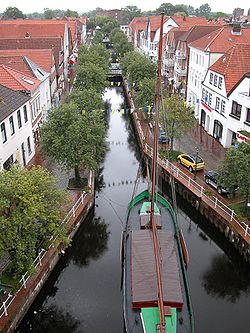Buxtehude
| Buxtehude | ||
|---|---|---|
 |
||
|
||
| Coordinates: 53°28′37″N 9°42′4″E / 53.47694°N 9.70111°ECoordinates: 53°28′37″N 9°42′4″E / 53.47694°N 9.70111°E | ||
| Country | Germany | |
| State | Lower Saxony | |
| District | Stade | |
| Government | ||
| • Mayor | Jürgen Badur (Ind.) | |
| Area | ||
| • Total | 76.49 km2 (29.53 sq mi) | |
| Population (2015-12-31) | ||
| • Total | 40,173 | |
| • Density | 530/km2 (1,400/sq mi) | |
| Time zone | CET/CEST (UTC+1/+2) | |
| Postal codes | 21614 | |
| Dialling codes | 04161, auch 04163, 04168 | |
| Vehicle registration | STD | |
| Website | www.stadt.buxtehude.de | |
Buxtehude (German pronunciation: [bʊkstəˈhuːdə]) is a town on the Este River in Northern Germany in the district of Stade and part of the Hamburg Metropolitan Region (Metropolregion Hamburg). Buxtehude is a steadily growing medium-sized town and the second largest in the district of Stade. It lies on the southern borders of the Altes Land within easy reach of the city-state of Hamburg. West of it are the towns of Horneburg and Stade and to the south there are incorporated villages offering mostly upscale housing, e.g. Ottensen and Apensen.
Early signs of settlements are the Daensen folding chair from a Bronze Age tumulus near Daensen and the Ovelgönne bread roll from the Pre-Roman Iron Age of Northern Europe, which was found in a loam mine in Ovelgönne.
Since 1881 Buxtehude has had its own railroad station on the R50 line between Hamburg and Cuxhaven. In late 2007 this line was added to the rapid transit system of the Hamburg S-Bahn by the HVV.
Since 1928 there has also been a second railroad line crossing Buxtehude, the EVB, (Eisenbahn- und Verkehrsbetriebe Elbe-Weser, Zeven) between Hamburg's outermost district and Bremerhaven on the coast of the North Sea. The Este river connects the town to the important Elbe river 6 miles north. Earlier in history this connection was used to ship goods into the small harbour, which still exists but has become less accessible due to town developments and aggradation.
...
Wikipedia



